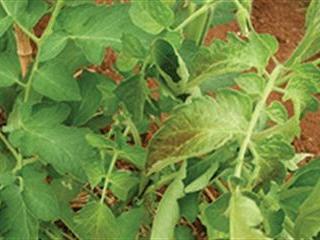
Tomatoes are especially affected, as thrips is a major vector of tomato spotted wilt virus, a serious plant disease.
This species is attracted to flowers, hence the name. Damage isn’t confined to flowers, though, as is the case with the cabbage family. Thrips have a very rapid life cycle, usually two to three weeks. The adults are 1mm to 2mm long, with the females being larger than the males.
Unmated females lay eggs which produce males only, just as with honey bees. The female lays 150 to 300 eggs and there are two nymphal stages before the pre-pupa, and then pupa, stage. The eggs are laid under the skin of plants, and it’s in the two nymphal stages that spotted wilt virus can be picked up. The adults which emerge from these pupae are then able to transmit the virus.
Control
Control is very difficult, as a high percentage of the population in a tomato crop is within flowers, where it’s protected.
If your plants are badly ‘infested’, your best chemical option is frequent applications over a short period. In the pupa stage, thrips are virtually immune to insecticides, but by spraying every two to three days over their life cycle, you’ll be able to catch them at a vulnerable stage and place.
As with any pest which has a rapid life cycle, resistance to pesticides occurs quickly, which means changing over to a product with a different mode of action on a frequent basis. This will preserve the lifespan of the most effective products.
Products containing the active ingredient Spinosad are effective, but resistance has been built up in some countries and areas by not rotating insecticides.
It’s a common error. When many farmers find an effective product, they keep on using it over a long period. All it then takes is for one insect to become resistant. By the time the farmer realises the product isn’t as effective as before, it’s too late – a large percentage of the population will be passing on the resistant gene to their offspring.
Signs
Fortunately, when it comes to spotted wilt, there is the Sw-5 gene, which is effective in providing the plant with resistance to this virus. There are, however, some speciality tomato varieties where the gene hasn’t yet been incorporated.
The virus is easy to spot. In the early stages, the plant becomes a duller colour and droops slightly. Later, the drooping becomes exaggerated and spots appear on the leaves.
Remove infected plants immediately. A convenient way of disposal is to place the plants in a clear plastic bag and leave it in the sun with the opening folded under the bag to seal it. The plant and thrips will quickly be cooked.
Weeding
It’s also important to rid the area of weeds which are hosts to this disease. There are many of them. Any weed which has virus symptoms should be removed. Overwintering weeds in cool areas, such as sow thistles and mallow, are likely to take the virus through the off-season and on to the new crop.
Since I started doing this, spotted wilt has disappeared from my property, and last year I didn’t have one infected tomato plant. I’ve also seen this practice work with peppers.
On tomatoes there is another problem with thrips. In the flower, they’re able to damage the small, undeveloped fruit even before pollination has taken place. They feed by rasping with a modified left jaw. Often the wound causes the anther cone to fuse with the stigma. This results in deformed fruit which look as though it has a zipper on one side.
Where you have a spotted wilt resistant variety, you may need to control thrips to reduce this type of damage.
Contact Bill Kerr at [email protected]. Please state ‘Vegetable production’ in the subject line of your email.












